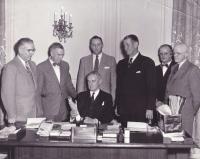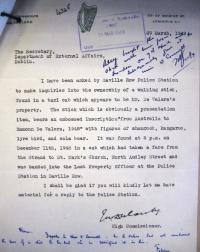Twitter not just for twits: DIFP goes digital
Published in 20th-century / Contemporary History, Issue 5 (Sept/Oct 2012), News, Volume 20
Conventional but quirky photo of diplomat John J. Hearne to which the following tweet was attached: ‘Irish Ambassador to USA in the 1950s John J. Hearne gets St Patrick statue gift; judging by his face one of many’. (Hearne family)
Readers of History Ireland will be familiar with the Documents on Irish Foreign Policy (DIFP) series, a project of the Royal Irish Academy. The project publishes essential source material for anyone interested in the development of Irish foreign policy since 1919. Many of you might have your own hard-copy volumes or have searched for the dark green book spines on the shelves of your local libraries.
DIFP first ventured on-line in 2007 at www.difp.ie, where previous volumes in the series were made freely available and are fully searchable. It has been a remarkable success and to date has had almost a quarter of a million page views worldwide. It soon became clear that there was a huge appetite for this type of digital primary source consumption, not only on the part of researchers and students but also amongst the general public and the Irish diaspora, something only reinforced by the immense success of the National Archives of Ireland’s Census Online project.
Not wanting to be left behind, last year DIFP ventured onto Twitter. Once it became apparent that a digital image could be attached to a tweet, we realised that there was a place for documents that did not make it into the hard-copy books. Sometimes, during the research phase of work for a volume, intriguing or quirky documents not relating to the execution of policy or with a personal slant come to light. Documents about de Valera losing his walking stick in a London black cab or on Irish soccer matches behind the Iron Curtain would not make it into the final hard-copy volume. Yet they are significant documents in their own right and deserve to reach a wider audience. Many of these documents would otherwise go back into their boxes until the next researcher chanced upon them, but now they have a virtual home! Gradually an on-line repository of images is being created, a complementary and digital history of Irish foreign policy.

‘1949 Eamon de Valera’s walking stick found by London cabbie.’ (NAI)
In addition, many of our Twitter followers might not previously have been familiar with primary sources and images of original documents. These visuals have an immediate impact on people beyond the text alone. Our tweets often spark discourse and thought; they breathe new life into old documents and reveal aspects of Ireland’s hidden past.
This year DIFP embarked on another digital initiative. With the help of the Digital Humanities Observatory (DHO) and the National Archives of Ireland, an e-book on the Anglo-Irish Treaty negotiations was created for iPads and Kindles and has been made available for free download. Beginning in December 1920, the e-book runs to January 1922. It contains crucial communications between the main political figures involved in the negotiations. It shows the problems and stresses of negotiating an international agreement. In particular, readers will see the growing rift between de Valera in Dublin and Arthur Griffith and Collins in London. The documents are structured chronologically and provide a gripping and accessible account of this key moment in modern Irish history. The Anglo-Irish Treaty e-book is a significant development; it is the first of its kind and it is good news for second-level history teachers and students. One of the prescribed topics for the documents-based study in the Leaving Certificate 2014 and 2015 is ‘The Treaty negotiations, October–December 1921’, so the e-book is an essential educational resource and will make accessing documents relating to the Treaty as straightforward as possible for secondary school students. Download it as part of your ‘back to school’ prep!
Although this can all be viewed as natural progression towards digitisation, DIFP embraced free web access to documents in advance of similar projects in other countries. The force behind these steps is not just a result of increased engagement with the growing field of ‘digital humanities’; it stems from a desire on the part of DIFP to make more history available to more people and underlines DIFP’s continued commitment to making historical documents freely available to the public. What better time to reinforce such sentiments than as we embark on the ‘decade of centenaries’? In the age of digital history, academics are no longer the sole mediators of the past. Increased digital access reveals our history to us in a new and profound way. It is there for all of us to peruse. HI
Kate O’Malley is the Assistant Editor of Documents on Irish Foreign Policy (DIFP). The e-book is a collaborative venture between DIFP, the Digital Humanities Observatory and the National Archives of Ireland. Follow DIFP on Twitter @DIFP_RIA. Download the e-book at: www.difp.ie or http://dho.ie.
















